Life in the USA is not normal. It feels pointless and trivial to be talking about small looks at the fascinating natural world when the country is being dismantled. But these posts have been scheduled for over a month, and they will continue, as a statement of resistance. I hope you continue to enjoy and learn from them.
During Permian time, about 268 to 272 million years ago, the Capitan Reef system developed in West Texas and southeastern New Mexico. The reef formed on the fringe of a deep basin to the southeast, and its presence constrained a shallow, saline lagoon to the northwest (labeled “Northwestern Shelf” on the drawing below), mostly in what is now New Mexico. The climate was hot; this location was a restricted arm of the sea not far from the Equator within the supercontinent of Pangaea, and the time was just 20 million years before the end-Permian extinction destroyed 70% to 96% of all species of life.

The shallow lagoon periodically dried up, with the last surviving hypersaline water precipitating all sorts of salts, from halite (common salt) to thick beds of gypsum (calcium sulfate). Some of those gypsum beds became what we call the Seven Rivers Formation today. In limited portions of the salt flat, unusual conditions sometimes prevailed. Enough silica entered the environment for quartz crystals to grow within the gypsum. These little doubly terminated crystals, from white to pink, yellow, red, and brown in color, weather out of the Seven Rivers formation gypsum and are called Pecos Diamonds for their occurrence along the Pecos River.
Most Pecos Diamonds would be recognized by even casual mineral collectors as quartz, from their hexagonal, prismatic forms with pyramidal terminations seen on most of the crystals in the photo at the top. But some of them are dominated by almost right angles, not the typical angles of hexagonal quartz, including the one in the photo above. For whatever reason, this crystal of quartz didn’t grow into the typical quartz hexagon. This crystal is mostly a rhombohedron, a hexagonal form whose angles in this case are close enough to 90 degrees to give this crystal a pseudocubic shape. I know it looks like a rectangle – but “pseudocubic” doesn’t mean it’s a false cube, it means it gives the false impression of belonging to the isometric (cubic) crystal system, which is dominated by 90-degree angles.
Often, even when quartz crystals are dominated by rhombohedrons rather than hexagonal prisms and pyramids, there’s a pair of rhombohedrons, positive and negative, and if they are developed equally or close to equally, the hexagonal symmetry is apparent. But if one is far more pronounced than the other, you can get these little not-quite cube shapes. But it’s still a quartz crystal, and it still has hexagonal symmetry (actually, trigonal, but usually it looks hexagonal), even if it isn’t completely obvious.
If the pair of rhombohedrons are almost equally developed (i.e., looking like a pair of hexagonal pyramids) and the prism faces are short or absent, you end up with a stubby doubly terminated crystal that looks like two pyramids (often referred to as dipyramidal, even though the forms are rhombohedrons), in what’s called the Cumberland habit for occurrences at Cumberland, England. The crystal above (also second from left in the top group) is getting close to showing the Cumberland habit.
When the two rhombohedrons develop in a manner intermediate to “about equal” (Cumberland) and “strongly favoring one” (pseudocubic), you can get one set of rhombohedrons dominating and giving a distinctly triangular aspect to the crystal shape. These are often called trigons, although that word is also used for unrelated triangular forms on quartz (and other) crystals related to the growth of that crystal face.
At a glance it’s possible to confuse distinctive dolomite crystals from these strata with some forms of Pecos-diamond quartz. Well-formed, sharp dolomite crystals, calcium-magnesium carbonate, from Lake Arthur, Chaves County, New Mexico, also weather out of gypsum. They are similar in form to the Spanish teruelite variety of dolomite, though the latter are usually black while the New Mexico examples are brown to golden in color. The dolomite crystal above is 12 mm in longest dimension.
I don’t think the origin of the silica that came into the salt flat to crystallize as Pecos Diamonds is settled. It might have been from wind-blown silt, or it might have been from the silica in sponge spicules. These quartz crystals are called authigenic, from Greek words meaning born there, because they grew in place rather than being brought in as sedimentary fragments from elsewhere.
For an excellent review of Pecos Diamonds, see Albright and Lueth, 2003, Pecos diamonds – quartz and dolomite crystals from the Seven Rivers Formation outcrops of southeastern New Mexico: New Mexico Geology, v. 25, no. 3, p. 63-74.
The name Pecos appears to come from an indigenous Tewa word, pàékilâ, which means the place above the water, according to the National Park Service. The word came into Spanish in the late 1500s as “Pecos.” The Tewa are a Pueblo people whose homelands are along the Rio Grande in New Mexico; their language is endangered, with only about 1,500 speakers, of which only a handful (estimated at 30) are fluent.




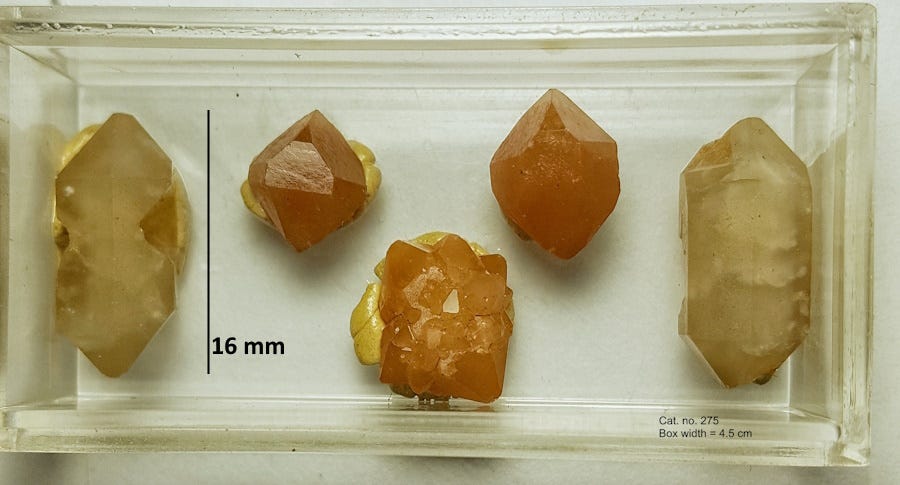
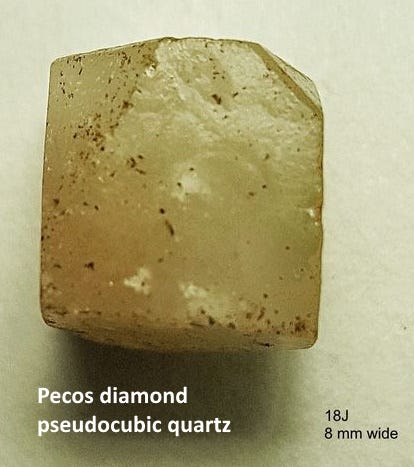
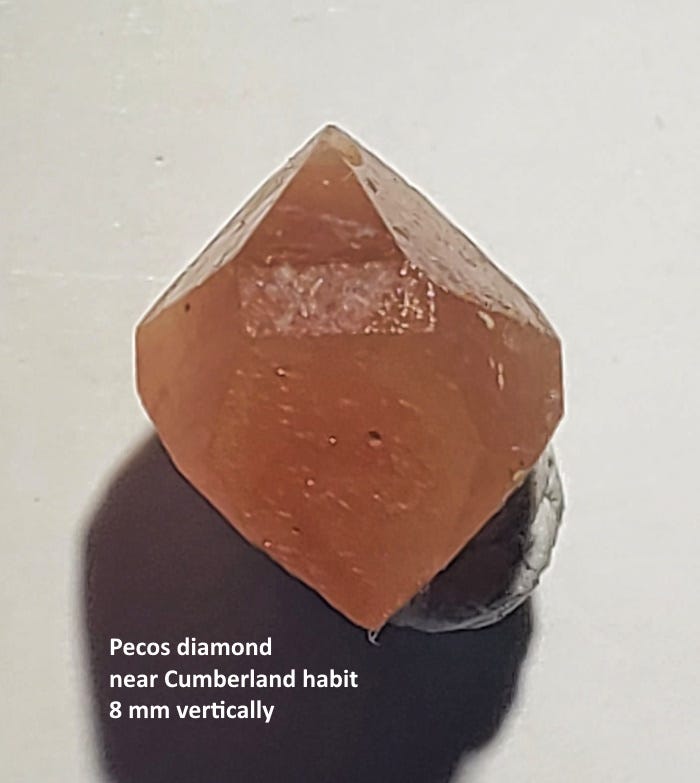
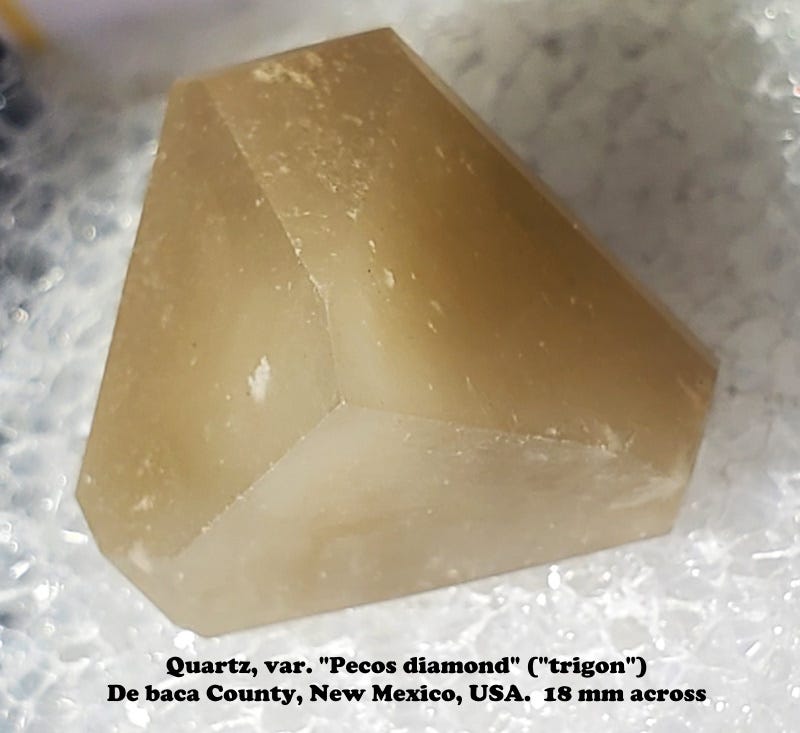
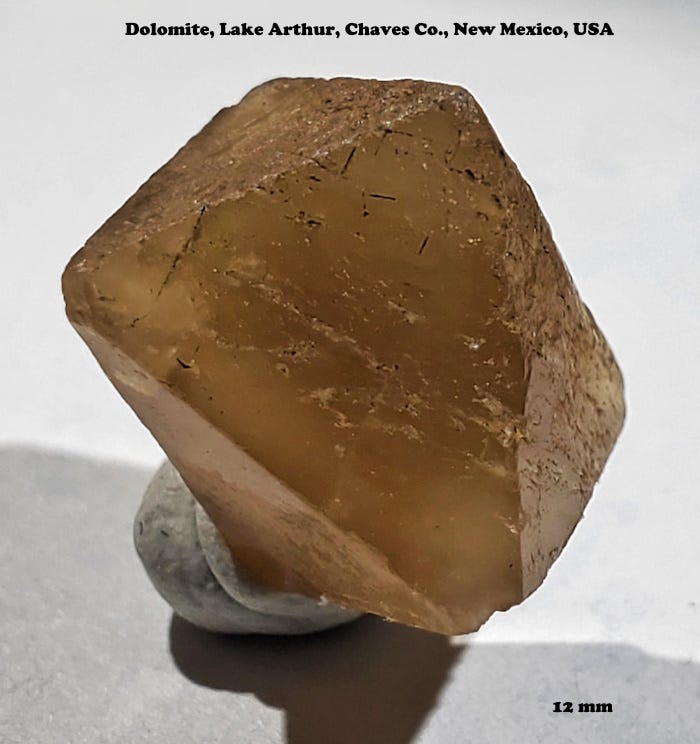
Thanks for this great blog. I really love Pecos diamonds! I found some really interesting large twinned pseudocubes near Conejo Mesa last month. They have edges up to 18mm long. They have lots of gysum inclusions and are colored green/gray.
Are you familiar with Qaisumah diamonds? We used to camp out in the desert so as to be awake at sunrise to see them sparkle on the desert floor. https://www.arabnews.com/node/1296781/saudi-arabia